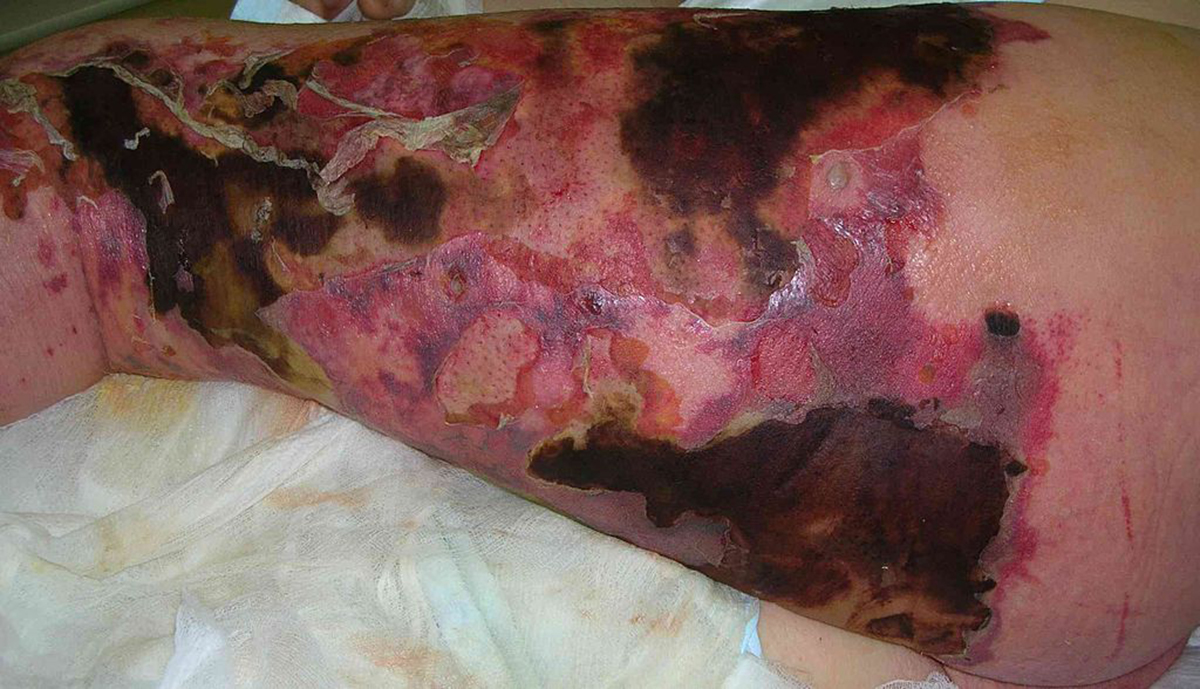Historically, necrotizing fasciitis was described by many people, dating back to the 1840s and 1860s. In 1952, the term 'necrotizing fasciitis' was first coined by Dr. B. Wilson. It is very probable that necrotizing fasciitis had been around for centuries before it was first noted in medicine in the 1800s.

Currently, there are many different terms used to denote necrotizing fasciitis and these include; Fournier's gangrene, necrotizing cellulitis, suppurative fasciitis, flesh-eating disease, flesh-eating bacterial infection and dermal gangrene.
The disease is rare and results in serious soft tissue damage. Necrotizing fasciitis can destroy fat, skin and tissue that covers muscles. It may sound frightening to think about contracting necrotizing fasciitis, but if a person is healthy and has a strong immune system, the chances of getting it are very low.
Necrotizing Fasciitis: Different Types
Necrotizing fasciitis can be classified into three general groups and it is based on the particular type of bacteria that is causing the infection. Type I is usually caused by more than two different bacteria's, or it could be due to a single bacteria and a fungus. Type II is most often the results of Streptococcus and Type III or gas gangrene is caused by Clostridium bacteria.
The Causes of Necrotizing Fasciitis
Most often bacteria is the cause of necrotizing fasciitis, but there is a chance the infection could be caused by other organisms. Group A Streptococcus and Staphylococcus, either alone or in combination with other bacteria cause most of the cases of necrotizing fasciitis. However, Clostridium bacteria needs to be examined, particularly if gas is noted in the infected tissue.
Because of better techniques for isolating bacteria, it is more common now that bacteria such as Clostridium and Peptostreptococcus, are showing up in cultures. Frequently, a clinician will send off a tissue sample if a person is suspected of having necrotizing fasciitis and the results can yield a mix of other nonaerobic bacteria such as Klebsiella, E. coli and Pseudomonas.
Necrotizing Fasciitis: Signs and Symptoms
Almost all cases of necrotizing fasciitis begin with an existing infection. An initial infection can result for almost any reason such as surgery, punctures or cuts to the skin or an insect bite. Instead of healing properly, a wound will start to become red, swollen and painful.
Normally, the signs and symptoms of necrotizing fasciitis begin within a few hours after an injury and can often present like another illness or injury. Some people who contract the infection may complain about pain or feeling sore, much like what would be experienced with a pulled muscle.
See Also: How Skin Changes Warn Us About Health Problems
Other things which may be noticed in the wound area include blisters, ulcers or black spots on the skin. People often describe the pain of necrotizing fasciitis as severe and unbearable. Often, a physician will note a person will have fever, chills, fatigue and vomiting. Because these signs and symptoms could mimic other illnesses, it may result in a delayed diagnosis.
Groups At High Risk
Necrotizing fasciitis is not discriminatory, it can happen to anybody. Nobody is immune to the chances of contracting this disease, overall good health has nothing to do with a person's susceptibility. However, just like with any other disease, there are certain high risk conditions and situations which can present an ideal opportunity for a necrotizing fasciitis infection.

The following groups of individuals are at high risk of developing necrotizing fasciitis and these include:
- Women giving birth
- Peripheral vascular disease
- Chronically ill people such as those with cirrhosis of the liver, HIV/AIDS, cancer, coronary disease and chronic renal failure, among others.
- Obese people
- Elderly
- Diabetics
- Children with chicken pox
- People taking immunosuppressive drugs
Diagnosis
When a person has a wound and displays the signs and symptoms of necrotizing fasciitis, prompt medical attention is critical.
The tests that may be performed in order to diagnose necrotizing fasciitis include; a CT scan, skin tissue biopsy and blood tests.
Treatment for Necrotizing Fasciitis
The medical treatment for necrotizing fasciitis will vary and must be administered according to the type of bacteria, the area of the body affected and many other factors. Generally, the treatment will include the following:
- Surgical debridement
- Broad spectrum antibiotics administered intravenously and tailored to kill of the causative bacteria
- Amputation
- Medically induced sedation/coma and ventilation
- Vacuum assisted closure to remove edema, increase blood flow and to enhance healing
- Treating any complications such as toxic shock, respiratory distress and/or organ failure
- Skin grafts
- Aggressive wound care and routine, repeat lab testing
- IVIG: Intravenous immunoglobulin which is not standard, but has been shown to be effective
- Hyperbaric oxygen therapy, not standard care but it has also been proven effective
The first line of treating necrotizing fasciitis is strong intravenous antibiotics. However, sometimes bacterial toxins can be destructive to the soft tissue and antibiotics might not be able to reach the infected and dying areas. In these cases, when antibiotics are not enough, a person may need to have the decaying tissue excised through surgery.
Necrotizing Fasciitis: Statistics
According to the Centers for Disease Control (CDC), there are between 9,000-11,500 people each year diagnosed with necrotizing fasciitis caused by group A streptococcus. Of these individuals diagnosed, only 6-7 percent of cases are invasive, which means the infection has spread to healthy body tissues.
Necrotizing Fasciitis: Prevention Methods
The best way to prevent necrotizing fasciitis is for people to use common sense and exercise good wound care. It is important to keep wounds that are open or draining, covered with a clean, sanitary bandage until healed. Do not delay seeking medical attention for an open wound or active infection, because necrotizing fasciitis can come on suddenly and spread quickly.
While a wound is still open, you should avoid common use sites like hot tubs, swimming pools and whirlpools, because it could spread bacteria around. Remember to wash your hands with soap and water or use an alcohol sanitation wash, if it is not possible to wash your hands.
See Also: Porphyria: A Rare And Painful Disorder
Prognosis
Necrotizing fasciitis is an aggressive and potentially deadly infection. The long-term prognosis and survival for those with the disease will depend on the type of medical care a person receives and whether or not the infection can be eliminated. According to the US National Library of Medicine, National Institutes of Health, people who survive a bout of necrotizing fasciitis are at a continued risk of dying a premature death and many deaths from the disease are the results of a secondary infection. Seek medical attention at once and do not ever ignore the signs and symptoms of necrotizing fasciitis, because it a disease that with swift intervention can be treated and resolved.
- Photo courtesy of Wikimedia Commons: upload.wikimedia.org/wikipedia/commons/thumb/6/6a/Necrotizing_fasciitis_left_leg.JPEG/1024px-Necrotizing_fasciitis_left_leg.JPEG
- Photo courtesy of Skley via Flickr: www.flickr.com/photos/dskley/8683527373

